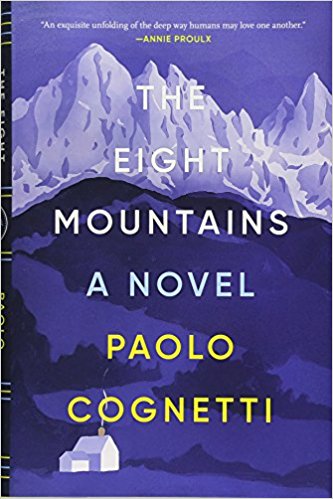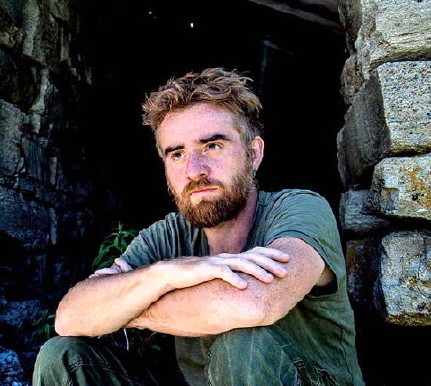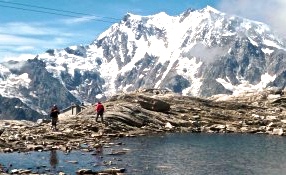Note: This novel was WINNER of the Strega Prize, Italy’s highest honor, when it was published in Italy in 2017.
“I peered over the rock…I did not know what I was supposed to see: beyond the rock the river formed a small waterfall and a shadowy pool, probably knee-deep. The surface of the water was unsettled, agitated by the churning fall. At the edges floated a finger’s depth of foam, and a large trapped branch sticking out diagonally had collected grass and sodden leaves around itself. It wasn’t much of a spectacle, only water that had run there from the mountain. And yet it was spellbinding: I don’t know why.”—Pietro Guasti, age 12.
 In 1984 twelve-year-old Pietro Guasti and his parents arrive in Grana, a quiet mountain village in northern Italy between Turin and Milan. Both parents love climbing the mountains, and though Pietro’s mother, a former nurse, does not enjoy climbing beyond the three-thousand foot mark, his father, who is at heart a loner, routinely climbs to the peaks of the higher mountains which attract him. Grana, a tiny farming village, has been losing its population, but it is in the foothills of Monte Rosa, a well-known climbing location, which makes it attractive as a vacation site, with an atmosphere far different from Pietro’s home in Milan. Pietro becomes fast friends almost instantly with Bruno Guglielmina, a local youth his age who is in charge of his family’s cows. Together they explore the mountain, the abandoned farms, a former school, and other places testifying to the decline of the village economy but fascinating for the images they conjure for the boys.
In 1984 twelve-year-old Pietro Guasti and his parents arrive in Grana, a quiet mountain village in northern Italy between Turin and Milan. Both parents love climbing the mountains, and though Pietro’s mother, a former nurse, does not enjoy climbing beyond the three-thousand foot mark, his father, who is at heart a loner, routinely climbs to the peaks of the higher mountains which attract him. Grana, a tiny farming village, has been losing its population, but it is in the foothills of Monte Rosa, a well-known climbing location, which makes it attractive as a vacation site, with an atmosphere far different from Pietro’s home in Milan. Pietro becomes fast friends almost instantly with Bruno Guglielmina, a local youth his age who is in charge of his family’s cows. Together they explore the mountain, the abandoned farms, a former school, and other places testifying to the decline of the village economy but fascinating for the images they conjure for the boys.
The quotation which opens this review is Pietro’s reaction to an experience he has in the mountains with Bruno, a place which Pietro does not recognize, at first, for the “miracle” that it is. As he stares at the water, however, Pietro suddenly realizes that “there was something moving beneath it…four tapering shadows with their snouts facing into the current, with only their tails moving slowly from side to side.” What Pietro finds so remarkable is that “we were further down the valley than they were, which was why they had not noticed us yet.” The fish – trout – were hunting, giving the lie to the idea that fish swim with the current, something Bruno knew already because he had observed it. This very early scene is in many ways symbolic of this novel itself, a consummately quiet, peaceful novel in which nothing much “happens.” Yet it is magical, even for those of us who do not fish for trout or climb mountains, a novel in which the author follows Pietro and Bruno from the age of twelve until they are in their early forties.

On his first climb with his father, Pietro is excited to see ibexes watching them, even as he is miserable from altitude sickness.
The reader comes to know Pietro and Bruno both separately and as members of their very different families, and as their lives continue to overlap in summers and, later, through Pietro’s separate visits to the village, their mutual respect, even love, for each other is a constant theme which provides a kind of anchoring stability even when they move in very different directions. A key component of their relationship, at first, is the presence of Pietro’s father, a hardworking, conscientious man with a desk job, a man who reveals little of himself to his son Pietro, but who has an instinctive connection with Bruno. A casual invitation to Bruno to join Pietro and his father for Pietro’s first big climb up the mountain becomes symbolic, as the father, rigidly focused on reaching the top of this 3000-foot peak, finds himself drawn more closely to Bruno, whose physical size and abilities make him a great, if untutored, climber, while his own son Pietro soon finds himself suffering the agony of altitude sickness, which he is afraid to reveal.
Two summers later, Pietro’s mother is waging war with Bruno’s family trying to ensure that Bruno, who has little interest in schooling, gets an education, and a confrontation with Bruno’s father ensues. Pietro’s own decision to stop participating in further camping experiences provides emotional blows to his father, who continues to climb on his own. Pietro begins short term rock climbing instead, with some of the wealthy tourists who have come to the mountain for vacations, and his father is devastated by his participation in what he regards as a lesser “social activity.” As he leaves Grana that summer, Pietro also leaves Bruno, and does not return for fourteen years. When he does return at age thirty-one, he reveals that he has moved from Milan to Turin to be on his own and lives in a studio flat. He is earning a living as a documentary filmmaker, is still single, and is still alienated from his father.

Turin, to which Pietro moved when his family life in Milan became too stifling. Grana is located between Milan and Turin.
Eventually, a special bequest from his father leads Pietro back to Grana and to Bruno, now a builder. When Bruno persuades Pietro to stay for the summer to help him rebuild an old house, Pietro decides to stay, gradually getting into better physical shape, climbing the mountain again and revisiting special places. At the end of summer, Pietro moves on to Asia, to make a film about the most dangerous mountain of all, Annapurna in the Himalayas, while Bruno stays in Grana with a woman who loves him. In the Himalayas, Pietro meets an old Nepalese man who provides a much-needed perspective about life: “The [old Nepalese] man picked up a small stick and drew a circle with it on the ground. Then, inside the circle he [drew]…a wheel with eight spokes [a mandala]….We believe that at the centre of the earth there is a tremendously high mountain, Sumeru,” he says. “Around Sumeru there are eight mountains and eight seas. This is the world for us…We ask who has learned the most, the one who has been to all eight mountains, or the one who has reached the summit of Sumeru?” As the novel winds its way to its conclusion, the answer to this mystical question becomes clearer.
The action throughout is quiet and thought-provoking, leaving the reader to sort through the various subplots and what they mean to both Pietro and Bruno as they try to find success – not financial success, but personal, emotional success – a sense of achievement based on effort and care for others. In this, the novel, which some refer to as a coming-of-age novel, expands its themes and its characters as some face a future which they may not have been expecting. Ultimately, Pietro has learned, unexpectedly from his father, that there may be certain mountains to which one can never return, and that visiting the eight mountains is all that remains for some. A surprising and very satisfying novel certain to appeal to those who appreciate understated, leisurely writing with much of value to say, and book clubs should love it.
ALSO by Cognetti, THE WILD BOY
Photos. The author’s photo appears on http://www.lecturissime.com
Pietro is excited when he sees an ibex while climbing, despite the fact that he is suffering from altitude sickness, which he does not want to tell his father for fear of disappointing him. http://www.cicukteb.com/
The massif of Monte Rosa faces them when they reach the summit: https://www.alpineinterface.com
Grana is located about halfway between Milan, where Pietro lived as a child, and Turin, shown here, to which he moved as an adult. https://www.10thingstodoandsee.com
Pietro plans to do a documentary about Annapurna in the Himalayas, the most dangerous mountain climbing experience of all. https://en.wikipedia.org



